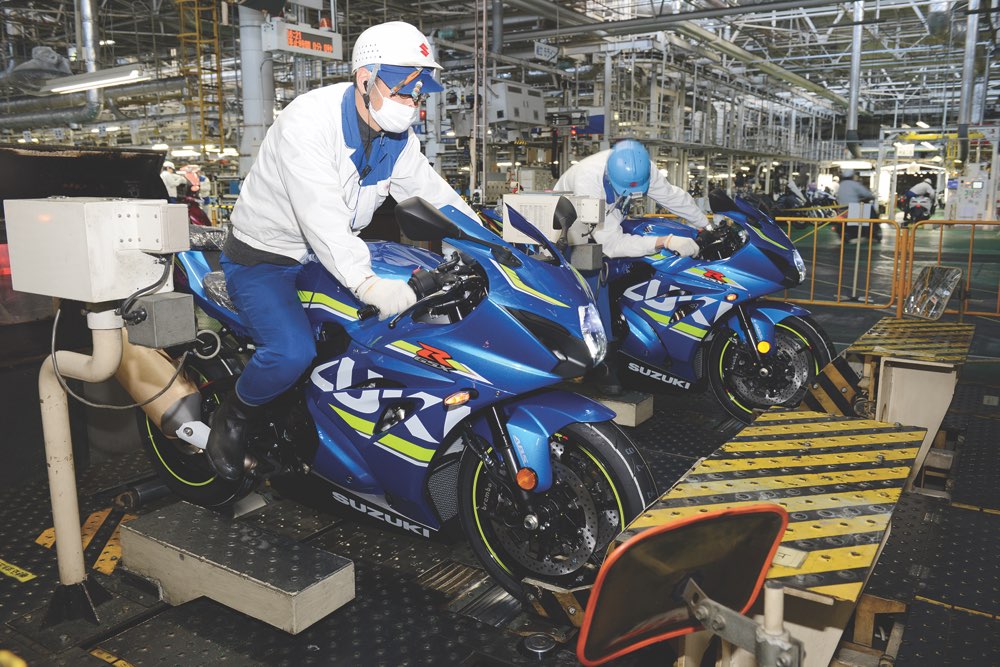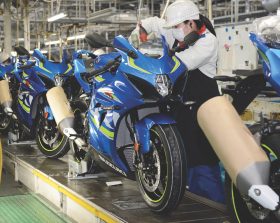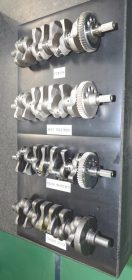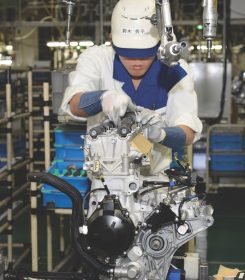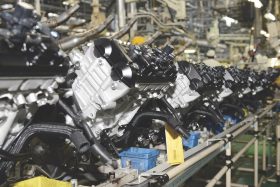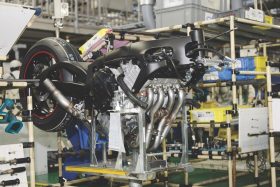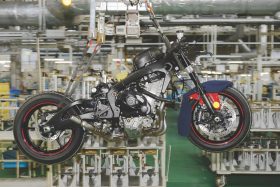Have you ever wondered how your motorcycle began its life?
Having worked on motorcycles for two decades professionally, and still personally, I’ve taken apart my fair share. But I’ve always been curious about how exactly they’re put together during the manufacturing process. Motorcycle Mojo was invited to Japan to visit the Suzuki factory, in conjunction with the launch of the new GSX-R1000R, which you’ll read about in an upcoming issue. Suzuki has six plants in Japan, and our hosts took us on a tour of the Takasuka engine plant and head office, the Toyokawa assembly plant and the Ryuyo test track.
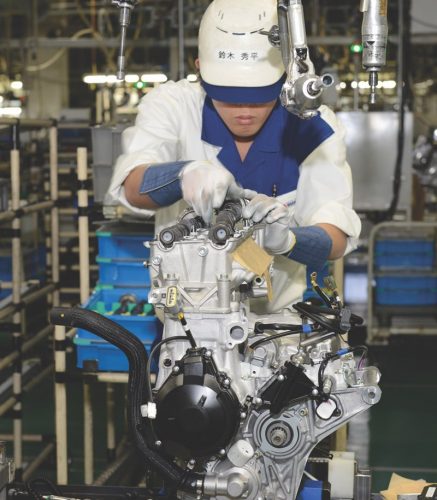 Unlike some manufacturing plants, where everything but casting is done in one location, Suzuki performs different tasks at its different plants. Raw engine castings and forgings arrive at the Takasuka plant, where all of the machining then takes place (any painting of the cases is done before any machining). Every machining process is measured and double-checked by laser measuring equipment. Once fully machined, the lower crankcase starts at one end of the assembly line and moves slowly along, collecting parts until it is a complete engine at the other end.
Unlike some manufacturing plants, where everything but casting is done in one location, Suzuki performs different tasks at its different plants. Raw engine castings and forgings arrive at the Takasuka plant, where all of the machining then takes place (any painting of the cases is done before any machining). Every machining process is measured and double-checked by laser measuring equipment. Once fully machined, the lower crankcase starts at one end of the assembly line and moves slowly along, collecting parts until it is a complete engine at the other end.
There are no robots on the assembly line, and everything is put together by hand, though there are some specialized machines that perform specific tasks, like the one that tightens the head bolts to spec all at once. I witnessed GSX-R1000 cams being installed and timed in about four minutes; it takes about 90 minutes to assemble a complete engine. Once the engine is complete, oil is added and it moves to a machine that spins the engine at about 1,000 rpm through the countershaft. This works all of the internal components and circulates the oil, while at the same time a worker inspects the engine for leaks. The engine is then put into a special crate and delivered to the assembly plant, which is 50 km away.
During our visit, one line was assembling GSX-R1000 engines and another was assembling V-Strom 1000 engines. Interestingly, also being built at the engine plant is the AR600, a highly specialized 599 cc, air-cooled parallel-twin that still uses carburetors, makes 59 hp and has only two speeds. Suzuki has been manufacturing this curiosity since the mid-1990s, and it is used solely in motorcycles taking part in Auto Race, a form of oval-track competition in Japan where spectators place bets, much like in horseracing.
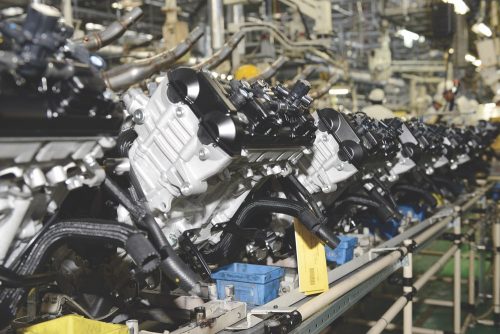 The Toyokawa plant was opened in 1971 and is Suzuki’s oldest plant. Suzuki currently manufactures 47 models, from 50 to 1,800 cc, but only a few models are assembled here, including the GSX-R1000, the GSX-S1000, the V-Strom 1000, the Burgman scooter and a 50 cc scooter. Suzuki also builds the TS185 dual-purpose bike here, an air-cooled two-stroke we last saw in Canada sometime in the 1980s. It’s still sold in South Africa and a handful of other countries that have lax emissions standards. Also being built at this plant is Suzuki’s largest engine, a 4.4-litre V6 that makes 300 hp.
The Toyokawa plant was opened in 1971 and is Suzuki’s oldest plant. Suzuki currently manufactures 47 models, from 50 to 1,800 cc, but only a few models are assembled here, including the GSX-R1000, the GSX-S1000, the V-Strom 1000, the Burgman scooter and a 50 cc scooter. Suzuki also builds the TS185 dual-purpose bike here, an air-cooled two-stroke we last saw in Canada sometime in the 1980s. It’s still sold in South Africa and a handful of other countries that have lax emissions standards. Also being built at this plant is Suzuki’s largest engine, a 4.4-litre V6 that makes 300 hp.
Surprisingly, it is not built for a car, which Suzuki still produces for other markets – it’s an outboard.
Putting together a motorcycle on a mass-production assembly line is a curious thing. The first step included lowering the engine onto the exhaust header. The frame was then lowered onto that assembly, and it moved forward as it gained components, like the swingarm assembly with the rear wheel and rear brake already installed, and front end. The whole thing inches along the 80-metre-long assembly line, eventually rolling out the other end 90 minutes later as a complete motorcycle, save for the windscreen and mirrors, which will be inserted separately into the shipping crate and installed at the dealer, thus preventing them from being damaged during transport. Despite all the activity, the plant is astonishingly quiet, and none of the workers wore earmuffs. The tooling, much of it operated by compressed air, was mostly silent.
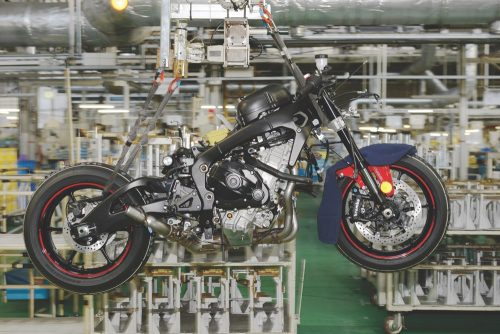 Soon after the bike rolls off the assembly line, a worker splashes some fuel into the tank, a battery is connected via cables and hung from the side, and the bike is propped up on a roller. This is where another worker sits on the bike, fires it up for the very first time and runs it through the gears. While on this machine, the ABS is also tested. With the proper approval, the bike moves on, the small amount of fuel is siphoned from the tank for delivery, and the bike goes for one final visual inspection under bright fluorescent lights, where the paint finish is scrutinized. It then moves onto another part of the plant where it is put into a crate and shipped to the various markets; the bikes we saw being assembled were going to Europe.
Soon after the bike rolls off the assembly line, a worker splashes some fuel into the tank, a battery is connected via cables and hung from the side, and the bike is propped up on a roller. This is where another worker sits on the bike, fires it up for the very first time and runs it through the gears. While on this machine, the ABS is also tested. With the proper approval, the bike moves on, the small amount of fuel is siphoned from the tank for delivery, and the bike goes for one final visual inspection under bright fluorescent lights, where the paint finish is scrutinized. It then moves onto another part of the plant where it is put into a crate and shipped to the various markets; the bikes we saw being assembled were going to Europe.
If you’ve ordered a new Suzuki GSX-R1000, it is probably being built as you read this.
Technical articles are written purely as reference only and your motorcycle may require different procedures. You should be mechanically inclined to carry out your own maintenance and we recommend you contact your mechanic prior to performing any type of work on your bike.









